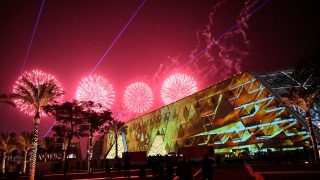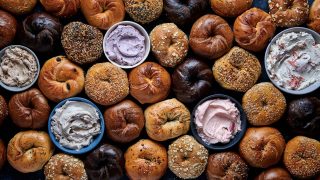In our series Place at the Table, we look at diasporic enclaves around the world through their cuisines—and the people who, in trying to recreate a taste of home, have forged exciting food scenes that invite others in.
Step into Hop Alley in Five Points and you’ll be hit with lively table conversation and the scent of sizzling woks. Plates of la zi ji—crispy battered chicken piled with dried chilis, Sichuan pepper and Ichimi Togarashi—are common, as are gai lan stir-fries finished with oyster sauce, wood fire smoke and schmalz, and shrimp toast dressed with garlic-ginger vinaigrette and mustard gastrique. Hop Alley, a Michelin Bib Gourmand awardee, riffs on Chinese classics with global techniques and unexpected ingredients, reflecting a broader trend: new Chinese restaurants flourishing alongside a rediscovery of Denver’s erased Chinese history.
Chinese laborers came to Denver in the late 1800s for railroad work and mining, but redlining confined many to Lower Downtown—then derisively called Hop Alley—where vice and exploitation were blamed on the community. Anti-Chinese racism culminated in an 1880 race riot in which 28-year-old Look Young was lynched; the violence helped justify the Chinese Exclusion Act of 1882. Later demolition waves in the 1940s and 1960s and gentrification in the 1990s—intensified by projects like Coors Stadium—obliterated physical traces of Chinatown. The Chinese American community dispersed, only beginning to grow again after the Immigration and Nationality Act of 1965.
Groups like Colorado Asian Pacific United (CAPU), founded to memorialize Asian American and Pacific Islander histories in Colorado, work to reclaim these stories. “There’s no architecture or long-standing businesses [from Chinatown], so a lot of [CAPU’s] work has been to reclaim the story and elevate the amazing work that the descendant families have been doing to maintain their history,” says co-founder and executive director Joie Ha. Food, central to passing on traditions, has become a key connector across generations and cultures in Denver’s small but tight-knit Asian American community (about 4% of the population).
Penelope Wong’s Yuan Wonton began as a 2019 food truck and grew into a brick-and-mortar after popping up before the pandemic. Wong, the child of first-generation Chinese restaurant owners, makes everything by hand—from wrappers and fillings to noodles and dough. Her menu features ultra-thin egg-wrapped wontons in chili oil, gua bao with crispy chicken and Thai basil, and sweet, tender char siu pork buns. During the 2020 surge in anti-Asian violence, Wong used her platform to share experiences and raise funds for local AAPI causes. Yuan Wonton moved into its current bright lunch-only space in 2023; Wong emphasizes worker balance, keeps evenings and weekends off, and has been recognized as a James Beard semi-finalist and finalist for “Best Chef: Mountain.”
Nana’s Dim Sum, run by Jack and Kelly Liu, builds on recipes Kelly learned from her grandmother. Kelly would return to China to refine family recipes, and today Nana’s serves hand-made dumplings—steamed or pan-fried—plus inventive dim sum like truffle soup dumplings, honey chicken feet and hot-and-sour dumpling soup. Family labor helped the business scale to seven Colorado locations and one in New York. Each location has a window into the kitchen so customers can watch staff fold dumplings, and employees contribute to refining recipes.
Doris Yuen and Ken Wan arrived in Denver after pop-ups in New York and opened MAKfam—a family-oriented evolution of their Meta Asian Kitchen pop-up. Their menu embraces heritage unapologetically (they proudly use MSG), with dishes like salt-and-pepper calamari topped with jalapeño and onions, stir-fried egg noodles with beef and crisp bean sprouts, and a savory corned-beef fried rice with pickled mustard greens and a fried egg. MAKfam is a Michelin Bib Gourmand and Wan was a James Beard semi-finalist for “Best Chef: Mountain.” Yuen and Wan have engaged locally, collaborating with CAPU for Lunar New Year commemorations.
Denver’s Asian culinary scene also includes long-standing Japanese influences. Chef Toshi Kizaki’s sushi restaurants—his newest, Kizaki, just earned a Michelin star—are known for deep supplier relationships in Japan and set a high bar for sushi in the city.
The Vietnamese community, rooted in Southwest Denver and shaped by refugees from the Vietnam War and their descendants, is the largest Asian diaspora in the area. Anthony “Ni” and Anna Nguyen moved from Los Angeles to join that community and opened Sap Sua, a restaurant that landed on New York Times, Esquire and Bon Appétit best-new lists, and earned the couple James Beard Emerging Chef semi-finalist recognition.
Though Denver lacks a continuous, standing Chinatown like New York, San Francisco or Los Angeles, the effort to restore its legacy through food and community is tangible. Restaurateurs are both preserving and reimagining family recipes, reclaiming derogatory names and histories, and using culinary platforms to educate and build solidarity.
Penelope Wong recalls learning about Denver’s erased Chinatown as an adult: “I remember being very angry, wondering why this hadn’t been publicized ages ago,” she says. She also felt guilt for having been validated in childhood fears about being Asian and trying to assimilate. Her daughter’s fluency in Mandarin—attending a Mandarin-immersion school and bringing homemade wontons for classmates—illustrates a generational shift. “During my childhood, I was begging my mom to just make me a ham and cheese sandwich. It’s incredible to see that things are changing.”





